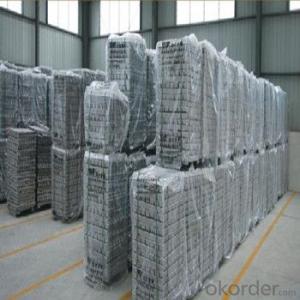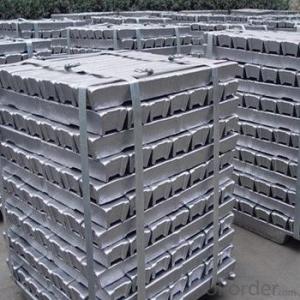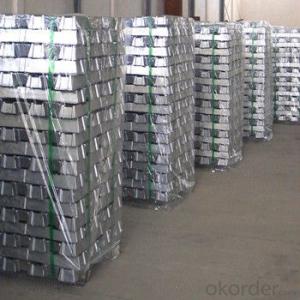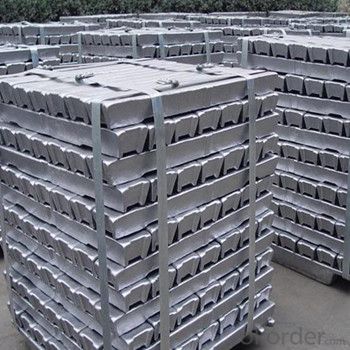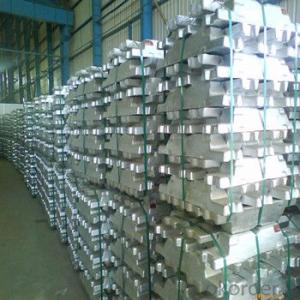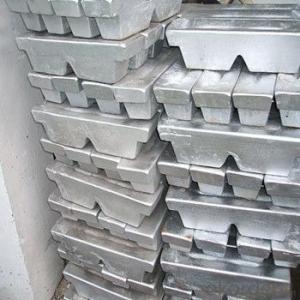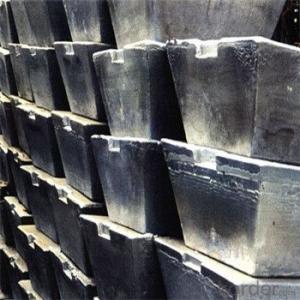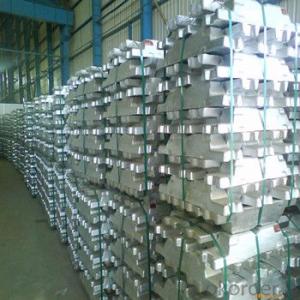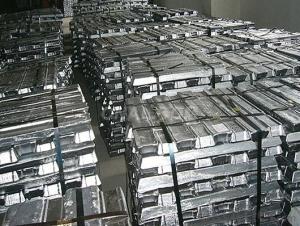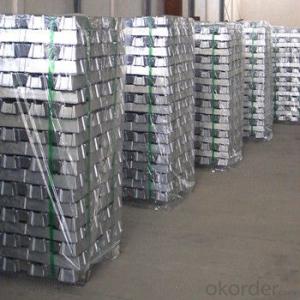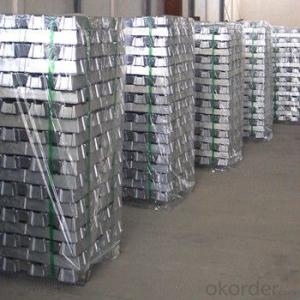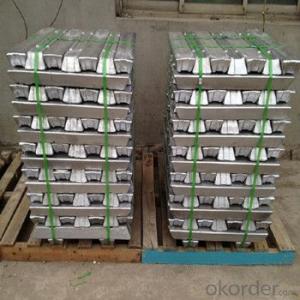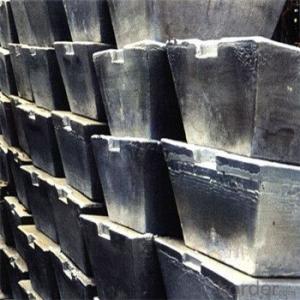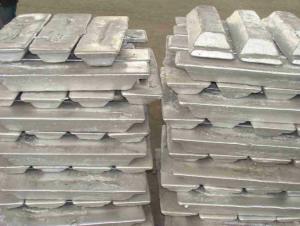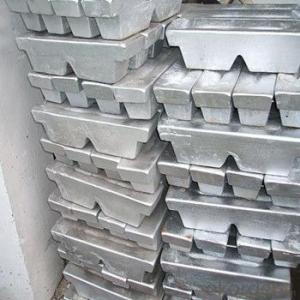Aluminum Pig/Ingot Sold With Wholesale By Mills
- Loading Port:
- China main port
- Payment Terms:
- TT OR LC
- Min Order Qty:
- 1000 m.t.
- Supply Capability:
- 100000 m.t./month
OKorder Service Pledge
OKorder Financial Service
You Might Also Like
Pure Aluminum Pig/Ingot Used for Industry
1.Structure of Aluminum Pig/Ingot
A material that has been cast into a shape in order to be transported and processed easier than in an unprocessed form. An ingot is typically rectangular in shape, which allows it to be stacked. Ingots are most commonly associated with metals, with ingots of gold held in the vaults of banks and brokerages being popular images.
Aluminum Ingot is with the AL as the main chemical composition.Aluminum Ingot is used for industry,such as automobile,pinning and weaving,electron broadly and so on. Aluminum Ingot has the following advantages: easy control and operation, fast melting.
2.Main Features of the Aluminum Pig/Ingot
•High Purity
•Easy control and operation
•High strength
•Fast melting
•Competitive price
•Best Service
3.Aluminum Pig/Ingot Images


4.Aluminum Pig/Ingot Specification
Grade | Chemical Composition % | |||||||||
Al≥ | impurities ≤ | |||||||||
Si | Fe | Cu | Ga | Mg | Zn | Mn | others | Sum | ||
Al99.9 | 99.90 | 0.50 | 0.07 | 0.005 | 0.02 | 0.01 | 0.025 | - | 0.010 | 0.10 |
Al99.85 | 99.85 | 0.80 | 0.12 | 0.005 | 0.03 | 0.02 | 0.030 | - | 0.015 | 0.15 |
Al99.7 | 99.70 | 0.10 | 0.20 | 0.010 | 0.03 | 0.02 | 0.030 | - | 0.030 | 0.30 |
Al99.6 | 99.60 | 0.16 | 0.25 | 0.010 | 0.03 | 0.03 | 0.030 | - | 0.030 | 0.40 |
Al99.5 | 99.50 | 0.22 | 0.30 | 0.020 | 0.03 | 0.05 | 0.050 | - | 0.030 | 0.50 |
Al99.00 | 99.00 | 0.42 | 0.50 | 0.020 | 0.03 | 0.05 | 0.050 | - | 0.050 | 1.00 |
5.FAQ of Aluminum Pig/Ingot
We have organized several common questions for our clients,may help you sincerely:
①How about your company?
A professional factory which foucs on producing the aluminum pig,can meet customers' requiement to the quality and grade.The quality also have been accepted by customer.Already got the good reputation among the customers.It have gotten lot of much experience.The facrtory has the professional Technical Worker and the advanced equipments for production.Beside,it has the profesional teams to operate the whole proess for exporting.OEM service is availble and welcome.The items have beedn exported around the world,and have been acceptable among the customers,and have gotten the good reputation already.No matter from the quality,price and service,can be guaranteed for the cusgtomers.High purity and diffent grade are available.
②How to guarantee the quality of the products?
We have established the international advanced quality management system,every link from raw material to final product we have strict quality test;We resolutely put an end to unqualified products flowing into the market. At the same time, we will provide necessary follow-up service assurance.
③How long can we receive the prod rking days, We will arrange the factory delivery as soon as possible. The pecific time of receiving is related to the state and position of customers.Commonly 7 to 10 working days can be served.
- Q: How is an aluminum ingot made?
- An aluminum ingot is made through a process called smelting, which involves heating aluminum ore (bauxite) in a furnace until it melts and becomes molten aluminum. This molten metal is then poured into molds, where it cools and solidifies into the shape of an ingot.
- Q: Are aluminum alloy ADC12 and aluminium ingot ADC12 the same?What's the difference? The price you see in Ali looks different
- Friends, you ask what is the same thing, the price is certainly not the same, the aluminum ingot price is floating
- Q: Who knows where needs aluminium ingot, aluminium powder, aluminium grain?
- 1. machinery raw materials factory.2. heat treatment smelting process.
- Q: How can the aluminum factory calculate the cost better?
- Cost of aluminum material = raw material price (futures aluminium ingot price) company's processing fee.
- Q: What are the environmental benefits of using aluminum ingots in manufacturing?
- Using aluminum ingots in manufacturing processes brings about various environmental advantages. To begin with, aluminum is an extremely recyclable material that can be reused multiple times without losing its quality or properties. This means that the utilization of aluminum ingots reduces the necessity for extracting and processing raw materials, thereby conserving natural resources and decreasing energy consumption. Moreover, recycling aluminum emits significantly lower greenhouse gas emissions in comparison to the production of new aluminum from primary sources. Additionally, aluminum is both lightweight and durable, making it an ideal material for a wide range of applications. By incorporating aluminum ingots into manufacturing, one can contribute to the production of lighter and more fuel-efficient vehicles, thus reducing carbon emissions from transportation. Similarly, using lightweight aluminum components in construction can lead to energy savings during operation and a decreased overall carbon footprint of structures. Furthermore, aluminum exhibits excellent corrosion resistance, which extends the lifespan of products made with aluminum ingots. This prolonged durability reduces the frequency of replacements, resulting in less waste generation and a reduced demand for new materials. Through the utilization of aluminum ingots, manufacturers can actively contribute to a more circular economy by promoting the reuse and longevity of products. Moreover, aluminum ingots possess a lower melting point compared to many other metals, requiring less energy for processing and manufacturing. This reduced energy requirement translates into lower carbon dioxide emissions and overall energy consumption during the production process. Lastly, aluminum is non-toxic and non-magnetic, making it suitable for a wide array of applications, including food packaging and medical equipment. This ensures that products made with aluminum ingots do not pose health risks or disrupt sensitive equipment. In conclusion, the employment of aluminum ingots in manufacturing processes brings forth numerous environmental benefits. From its recyclability and lightweight properties to its corrosion resistance and low energy requirements, aluminum ingots contribute to the conservation of resources, decreased emissions, and a more sustainable and circular economy.
- Q: Can aluminum ingots be used in 3D printing?
- Yes, aluminum ingots can be used in 3D printing. Aluminum is a commonly used material in additive manufacturing processes such as selective laser melting (SLM) or direct metal laser sintering (DMLS). By melting the aluminum ingots and layering it in a precise manner, it is possible to create complex and durable 3D printed metal parts.
- Q: How can I make a pop top aluminum ingot?
- Direct smelting into coarse aluminum ingot: the waste cans can be mixed in the smelting furnace, and finally a kind of metal ingot similar to the cooked aluminum is obtained. This kind of miscellaneous aluminium ingot is sometimes very pure in the market, which is very bad;
- Q: What is the melting point of aluminum ingots?
- The melting point of aluminum ingots is approximately 660.3 degrees Celsius or 1220.5 degrees Fahrenheit.
- Q: What quality aluminium ingots can be made out of pop cans?
- In fact, the recycled aluminum slag can also be used for smelting aluminum ingots. But it doesn't work well. It needs stirring and a lot of slag. There is also a saying that the only way aluminum slag smelting aluminum ingot is electrolysis, the use of reduction method is too expensive
- Q: What are the common uses of aluminum ingots?
- Aluminum ingots have a wide range of common uses due to their unique properties. One of the most common uses is in the manufacturing of various products in the automotive industry. Aluminum ingots are used to make engine components, such as cylinder heads and engine blocks, as well as body panels and wheels. The lightweight nature of aluminum makes it ideal for improving fuel efficiency and reducing vehicle weight. Another prominent use of aluminum ingots is in the construction industry. Aluminum is used to fabricate window frames, door frames, roofing materials, and structural elements. It is highly corrosion-resistant, which makes it suitable for outdoor applications. Additionally, its lightweight nature allows for easy installation and transportation. The packaging industry also heavily relies on aluminum ingots. Aluminum is used to make cans for beverages and food items due to its excellent barrier properties, which protect the contents from light, moisture, and air. Moreover, aluminum cans are easily recyclable, making them a sustainable choice. Aluminum ingots are also widely used in the electrical industry. They are utilized in the production of power transmission lines, electrical wiring, and conductors. Aluminum's high electrical conductivity and low weight make it an ideal material for conducting electricity efficiently and cost-effectively. Lastly, aluminum ingots find applications in the aerospace industry. The lightweight yet strong characteristics of aluminum make it an excellent choice for manufacturing aircraft components, including wings, fuselages, and structural parts. The weight reduction achieved with aluminum significantly improves fuel efficiency and overall performance. Overall, the common uses of aluminum ingots span across various industries, including automotive, construction, packaging, electrical, and aerospace. Its versatility, strength, and lightweight nature make it an essential material in modern manufacturing processes.
Send your message to us
Aluminum Pig/Ingot Sold With Wholesale By Mills
- Loading Port:
- China main port
- Payment Terms:
- TT OR LC
- Min Order Qty:
- 1000 m.t.
- Supply Capability:
- 100000 m.t./month
OKorder Service Pledge
OKorder Financial Service
Similar products
Hot products
Hot Searches
